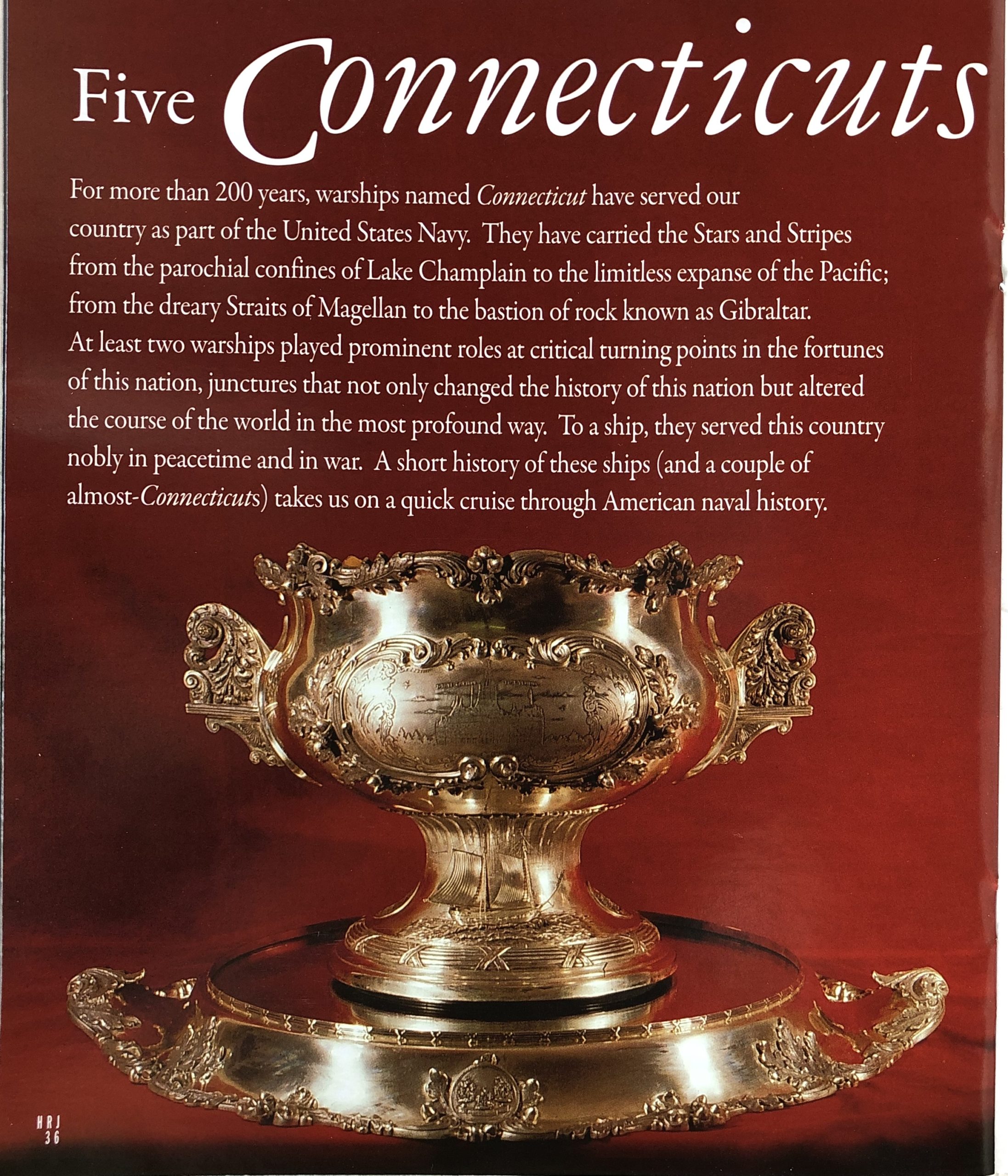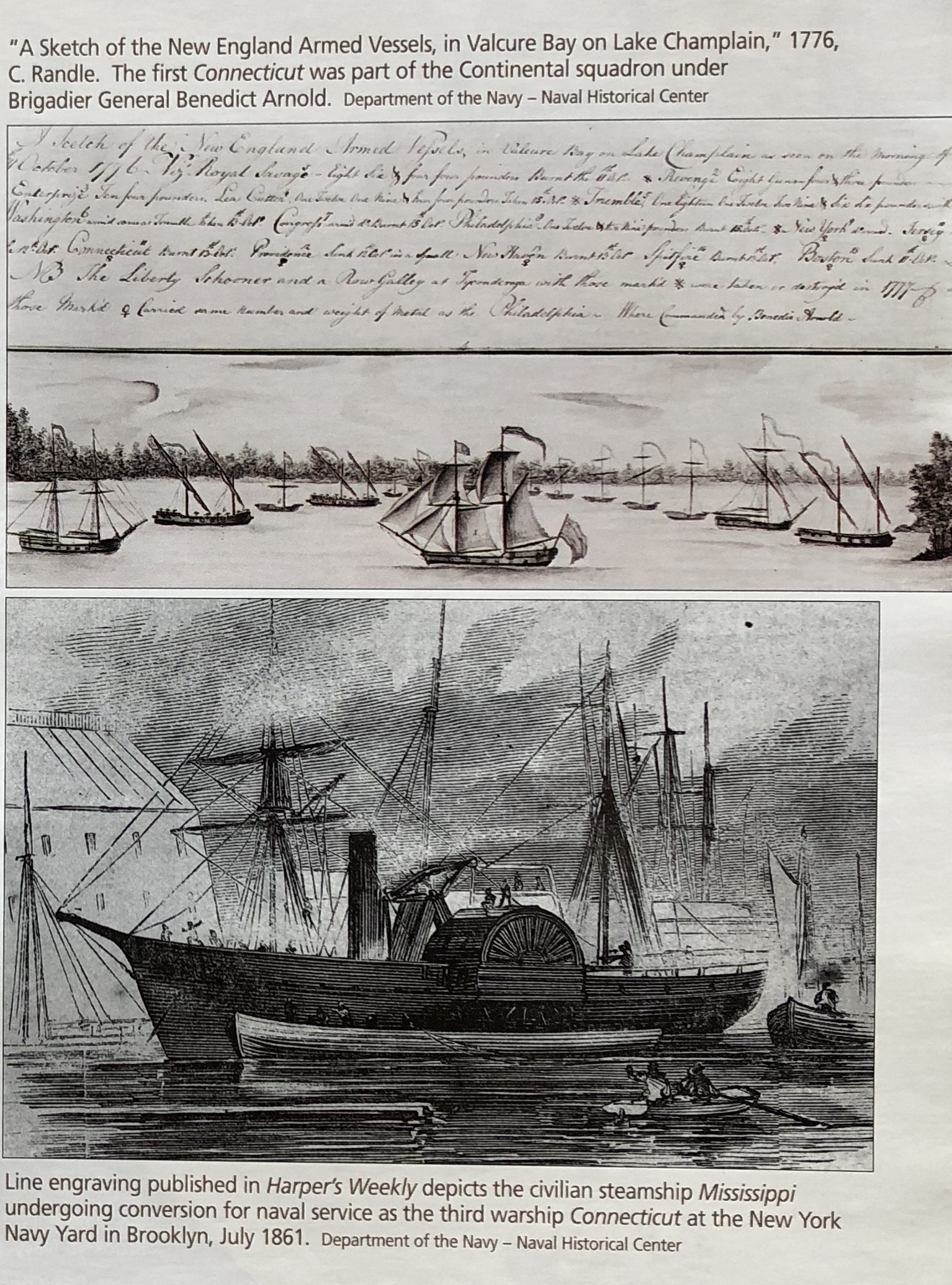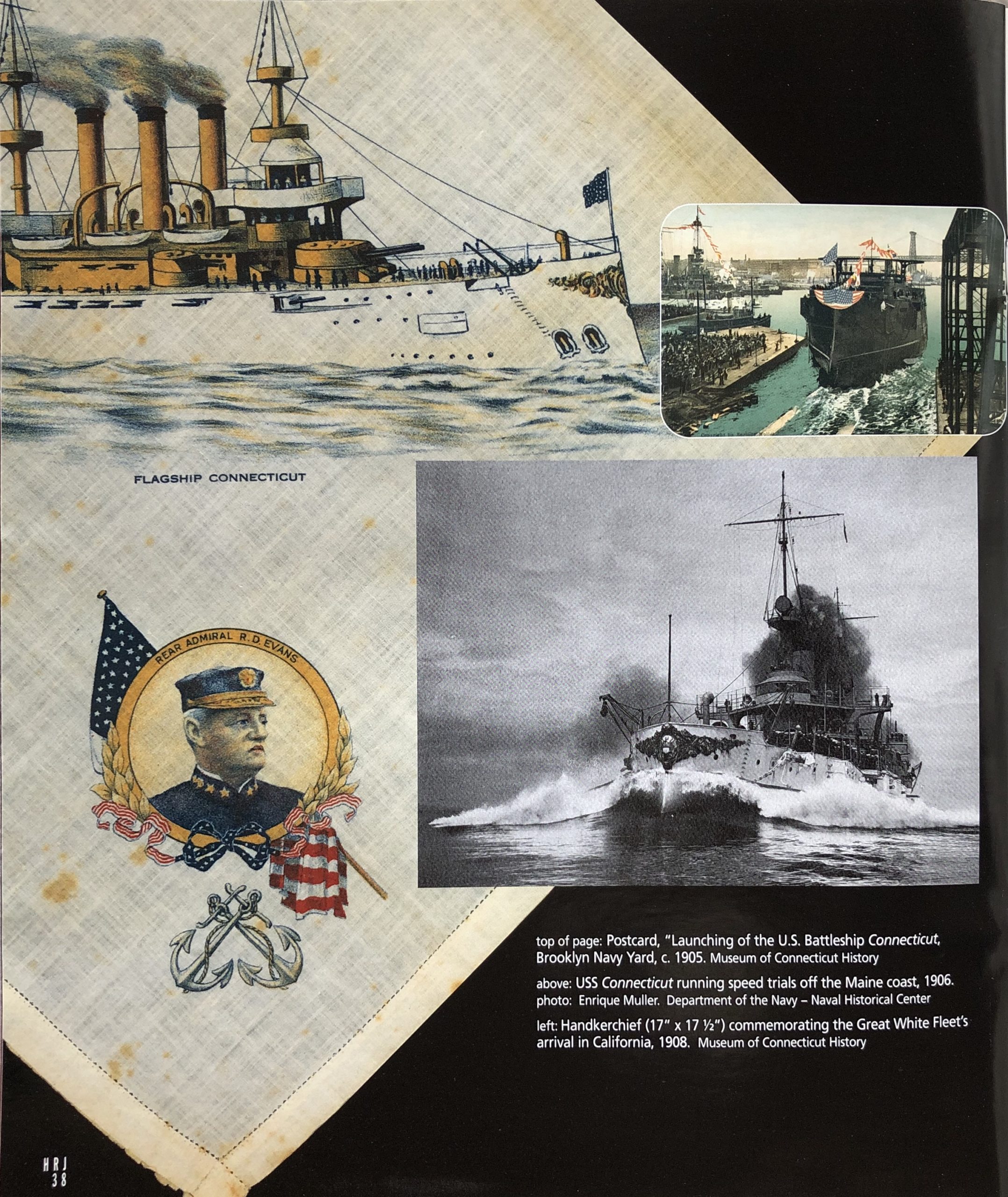
An image of the first warship “Connecticut” is molded in high relief on the ornate silver punch bowl that sailed with the fourth USS Connecticut. The silver service is on display in the governor’s residence in Hartford. Museum of Connecticut History
By Mark Albertson
(c) Connecticut Explored Inc. Spring 2009
Subscribe/Buy the Issue!
For more than 200 years, warships named Connecticut have served our country as part of the United States Navy. They have carried the Stars and Stripes from the parochial confines of Lake Champlain to the limitless expanse of the Pacific; from the dreary Straits of Magellan to the bastion of rock known as Gibraltar. At least two warships played prominent roles at critical turning points in the fortunes of this nation, junctures that not only changed the history of this nation but altered the course of the world in the most profound way. To a ship, they served this country nobly in peacetime and in war. A short history of these ships (and a couple of almost-Connecticuts) takes us on a quick cruise through American naval history.
STRATEGIC SACRIFICE IN THE REVOLUTIONARY WAR
By the summer of 1776, the war for independence was not going well for the rebellious American colonies. British forces, backed by Canadian troops, an Irish regiment, and German mercenaries, had evicted the American invaders from Canada. The British planned to follow up on this success with a drive deep into New York. The offensive would follow along the Lake Champlain-Lake George-Hudson River axis, severing New York from New England and effectively cutting the colonies in two.
General Benedict Arnold of Norwich, Connecticut organized an army of carpenters to build a fleet to meet the Royal Navy on Lake Champlain. One of the ships was a man-of-war named Connecticut.
The first Connecticut was built in Skenesborough—now known as Whitehall—New York. She was a gondola, a boat with a mostly flat bottom and a hull that was tapered sharply fore and aft. Its armament consisted of one 12-pounder, two 8-pounders, and eight small swivel guns. Forty-five soldiers of the Continental Army filled her complement. Captain Joshua Grant assumed command.
In late September, Arnold positioned his 15 warships off Valcour Island in Lake Chamberlain to await the British thrust. Coming south was Captain Thomas Pringle of the Royal Navy. Pringle enjoyed overwhelming superiority with 34 schooners and gunboats backed by miscellaneous smaller craft.
The opposing fleets collided on October 11. Arnold’s hopelessly outnumbered fleet waded into the British columns. For most of the day the slugfest continued, but British numbers carried the day. Arnold retreated with his galley Congress, and four gondolas, Connecticut, New Haven, Boston, and Providence. The flotilla sought refuge in Ferris Bay, in Panton, Vermont. With the pursuing British closing in, the Americans’ position was hopeless. The crews torched their ships and then melted into the forest.
 Pringle’s fleet carried the battlefield and won a tactical victory. But the British lost the strategic initiative. Their offensive started late, and Arnold’s intrepid little fleet helped to put the British off their timetable. With the onset of winter, Lake Champlain, Lake George, and the Hudson River would soon be clogged by ice. This caused the British to call off their offensive and retreat north for winter quarters in Canada. By the time the British renewed their offensive a year later, the American army was ready. American General Horatio Gates’s victory at Saratoga on October 17, 1777 preserved the northern colonies and helped to foster our important alliance with France. The sacrifice of the first Connecticut had played a vital role in one of the pivotal turning points in American history.
Pringle’s fleet carried the battlefield and won a tactical victory. But the British lost the strategic initiative. Their offensive started late, and Arnold’s intrepid little fleet helped to put the British off their timetable. With the onset of winter, Lake Champlain, Lake George, and the Hudson River would soon be clogged by ice. This caused the British to call off their offensive and retreat north for winter quarters in Canada. By the time the British renewed their offensive a year later, the American army was ready. American General Horatio Gates’s victory at Saratoga on October 17, 1777 preserved the northern colonies and helped to foster our important alliance with France. The sacrifice of the first Connecticut had played a vital role in one of the pivotal turning points in American history.
PROTECTING AMERICAN SHIPPING DURING THE QUASI WAR
In 1792, Britain and France were again at war. As the swing power of Europe, Britain was eager to stop the spread of the French Revolution and restore the French monarchy to the throne. The United States found itself in the middle, as the Royal Navy seized American ships bound for French ports.
The Jay Treaty of 1794 reduced friction between the British and Americans, but the agreement incensed the French, who saw it as a violation of the spirit of earlier Franco-American agreements. In response, the revolutionary government of France ordered the seizure of American ships. Cooler heads prevented a general war from breaking out but did not stop the clashes at sea, as the newly minted U.S. Navy swing into action against French pirates and privateers preying on American shipping. This became known as the Quasi-War, and it is in this quasi-conflict that the second warship named Connecticut made her appearance, joining other Yankee warships in the Caribbean where American shipping was most vulnerable to French raiders. This second Connecticut was built in Connecticut by Seth Overton and launched in Middletown on June 6, 1799. She displaced 492 tons, carried 26 12-pounder guns, and was crewed by 180 seamen, all under the command of Moses Tyron. On October 15, Captain Tyron shaped a course for the Caribbean.
Connecticut was attached to the American squadron at Guadalupe Island. The man-of-war went into action right away, recovering two American vessels that had been seized by the French a forcing a third to run aground.
Connecticut soon became renowned for her speed. Four days after Christmas, 1799, this asset proved decisive when she took on one of the most notorious pirate ships of the day. The French privateer Italia Conquese was one of the most successful pirate ships of the Quasi-War. In four years of raiding, this predator had captured or sunk 150 vessels. But she met her match in Connecticut. On sighting her antagonist, the raider turned to flee. With the wind in her sails, Connecticut chased down her quarry. Seeing no other recourse, the privateer turned to fight. The broadsides of the more heavily armed Yankee ship soon reduced the gun duel to target practice. The Frenchman’s rigging was shot to pieces, and her topsides were a shambles. The crew struck her colors, and Connecticut took the raider in prize.
 While President John Adams, through a delegation, sought peace with France, Connecticut continued to rove the waters of the Caribbean, hunting privateers and recapturing American vessels. On June 5, 1800 she took on La Unite. The French ship fled with Connecticut in hot pursuit. With the Yankee closing the gap, the pirate crew began to jettison everything not nailed down in an effort to gain more speed. But it was in vain. Connecticut overhauled the raider, ending a 12-hour chase.
While President John Adams, through a delegation, sought peace with France, Connecticut continued to rove the waters of the Caribbean, hunting privateers and recapturing American vessels. On June 5, 1800 she took on La Unite. The French ship fled with Connecticut in hot pursuit. With the Yankee closing the gap, the pirate crew began to jettison everything not nailed down in an effort to gain more speed. But it was in vain. Connecticut overhauled the raider, ending a 12-hour chase.
On July 15, Connecticut bagged her last privateer, Le Chou Chou, and was then ordered home. Back in New London, Captain Tryon turned over command to Richard Derby. Captain Derby was to see to Connecticut’s refit for her next posting, Batavia (Jakarta). Those orders were canceled when the United States and France finalized the Treaty of Friendship late in 1800. On April 1, 1801, Captain Derby sailed Connecticut to New York, where the gallant man-of-war was sold at public auction.
Read about a Wethersfield merchant whose ship was a victim of the Quasi War: Justus Riley and Justice for Patty, Spring 2019
BETRAYED BY A SOUTHERN BELLE IN THE CIVIL WAR
In 1861, a steamer named Mississippi was built in New York by William Webb. The Civil War had started, and the North desperately needed ships, so the U.S. Navy purchased the vessel and renamed her Connecticut. The side wheeler had a length of 251 feet 6 inches and a beam of 38 feet 2 inches. She tipped the scales at 1,725 tons and had a top speed of 10 knots. She carried 166 officers and men. Four 32-pounders and one 12-pounder filled out her fire power.
Connecticut proved a tireless workhorse. She ran stores and supplies to federal squadrons blockading southern ports. She evacuated wounded, towed ironclads, escorted convoys, and chased down blockade runners. On May 9, 1864, the Confederate Greyhound slipped her moorings and shipped out of Wilmington, North Carolina, bound for Bermuda. Lieutenant George Bier was in command. On the manifest were 820 bales of cotton, 35 tons of tobacco, and 25 casks of turpentine. In exchange, Bier was to bring back arms and ammunition from Britain.
Connecticut intercepted Greyhound the next day. Among the blockade runner’s passengers was a Miss Lewis—who was soon to be discovered to be none other than Belle Boyd, a notorious Confederate spy.
Ensign Samuel Harding, Jr. took command of the prize and steered for Boston. On the way, the scheming Boyd used her feminine wiles to persuade Ensign Harding to allow Captain Bier to escape. Indeed, when Greyhound anchored in Boston, the rebel captain was not aboard! This put an end to Ensign Harding’s naval career, and he was soon mustered out. He then journeyed to England—and married none other than Boyd.
Following Confederate General Lee’s surrender at Appomattox, the navy downsized the fleet. Connecticut ended her career at the Philadelphia Navy Yard. She was mustered out of the fleet and sold on September 21, 1865 to continue service as the commercial steamer South America until she was scrapped in 1879.
AMERICA’S FLAGSHIP
In 1863, the building of Pompanoosuc got underway at the Boston Navy Yard. She was to be a large, fast steam cruiser of 4,446 tons. On May 15, 1869, the steamer was renamed Connecticut. But she was never finished. Left derelict on the building ways for another 13 years, she was eventually scrapped in 1884.
On November 24, 1900, a warship briefly named Connecticut was launched at the Bath Iron Works in Maine. She was the second of four Arkansas-class monitors. But in January 1901 she was renamed Nevada. Two years later another hull was laid down, this time in the Brooklyn Navy Yard. This ship was destined to be the flagship of the greatest peacetime demonstration of naval power in modern times. She’s counted as the fourth warship named Connecticut. The not-yet-finished Connecticut was launched on September 29, 1904. More than 30,000 turned out to watch America’s newest and most powerful defender of liberty slide down the building ways. She was launched by Alice Welles, grand-daughter of former Secretary of the Navy Gideon Welles. Connecticut was completed two years later and commissioned into the fleet on September 29, 1906.
Connecticut was a pre-dreadnought battleship, a man-of-war powered by coal and boasting a variety of major caliber of main armament. She was the epitome of this type of American capital ship design. She was the lead ship of a class of six, including the Louisiana, Kansas, Vermont, Minnesota, and New Hampshire, that was the largest single class of battleships ever produced by the United States.
Connecticut served as flagship of numerous battleship squadrons and divisions. Twice she was flagship of the Atlantic Fleet, but her greatest honor was as flagship of President Theodore Roosevelt’s Great White Fleet. America’s flagship led 15 other battleships out of Hampton Roads on December 16, 1907. Over the next 14 months and 6 days, Connecticut sailed across 11 oceans and seas, crisscrossed the equator six times, called on more than 30 ports and logged more than 46,000 miles. As a roving ambassador, Connecticut put a good face upon America in every port-of-call; as a man-of-war, she ably demonstrated command of the seas and did so without her crew’s firing a single shot in anger. The epic circumnavigation of the globe was the first major strategic initiative by the United States in the 20th century, an endeavor that served notice to the world that the United States had arrived as a global power.
During World War I, Connecticut trained more than one thousand gunners for duty aboard America’s merchant ships. Fresh graduates from the Naval Academy trained aboard her decks before shipping out to the Atlantic Fleet.
But changes in naval design and technology had rendered the historic warship obsolete. America’s flagship had been reduced to the status of a bargaining chip to fulfill the terms of the Washington Naval Treaty of February 8, 1922. Connecticut was decommissioned on March 1, 1923 and sold for scrap eight months later to Walter W. Johnson in San Francisco.
“ARSENAL OF THE NATION”
The latest version of USS Connecticut (known as SSN-22) is an attack submarine of the Seawolf class. Built by the Electric Boat Division of General Dynamics in Groton, Connecticut, she was commissioned into the fleet on December 11, 1998.
 SSN-22 is 353 feet long and 36 feet wide. Her submerged displacement is 9,138 tons. Her complement is 14 officers and 126 sailors. She is nuclear powered, and her single shaft can push her through the water at 25 knots. She can attain submerged speeds of at least 35 knots, and she can dive to depths of 1,600 feet.
SSN-22 is 353 feet long and 36 feet wide. Her submerged displacement is 9,138 tons. Her complement is 14 officers and 126 sailors. She is nuclear powered, and her single shaft can push her through the water at 25 knots. She can attain submerged speeds of at least 35 knots, and she can dive to depths of 1,600 feet.
As an attack submarine, Connecticut’s mission is to seek out and destroy enemy surface combatants and submarines and engage in mine-layering operations. When attached to the fleet Connecticut can support surface task forces and aircraft carrier battle groups. She can attack shore targets with submarine-launched Tomahawk cruise missiles and serve as a vehicle for special operations forces and reconnaissance and intelligence activities. To perform these duties, Connecticut offers an impressive array of weaponry that can be fired form her eight 660-mm torpedo tubes.
Connecticut is well suited to her task of defending America’s shores. Her weaponry and technology lend credence to the ship’s nickname, “Arsenal of the Nation.” And like her predecessor battleship Connecticut, SSN-22 maintains the principle of command of the seas.
SSN-22 is another in a line of historic warships that have proven to be stalwart pillars in America’s defense and as such have added glorious chapters to the nation’s maritime annals. And like the state for which each was named, each of these ships is indelibly inscribed in the American saga.
Mark Albertson is a historical research editor at Army Aviation magazine, historian for the Army Aviation Association of America. He has written two books about battleships.
Explore!
Read all of our stories about Connecticut’s Maritime history on our TOPICS page.
